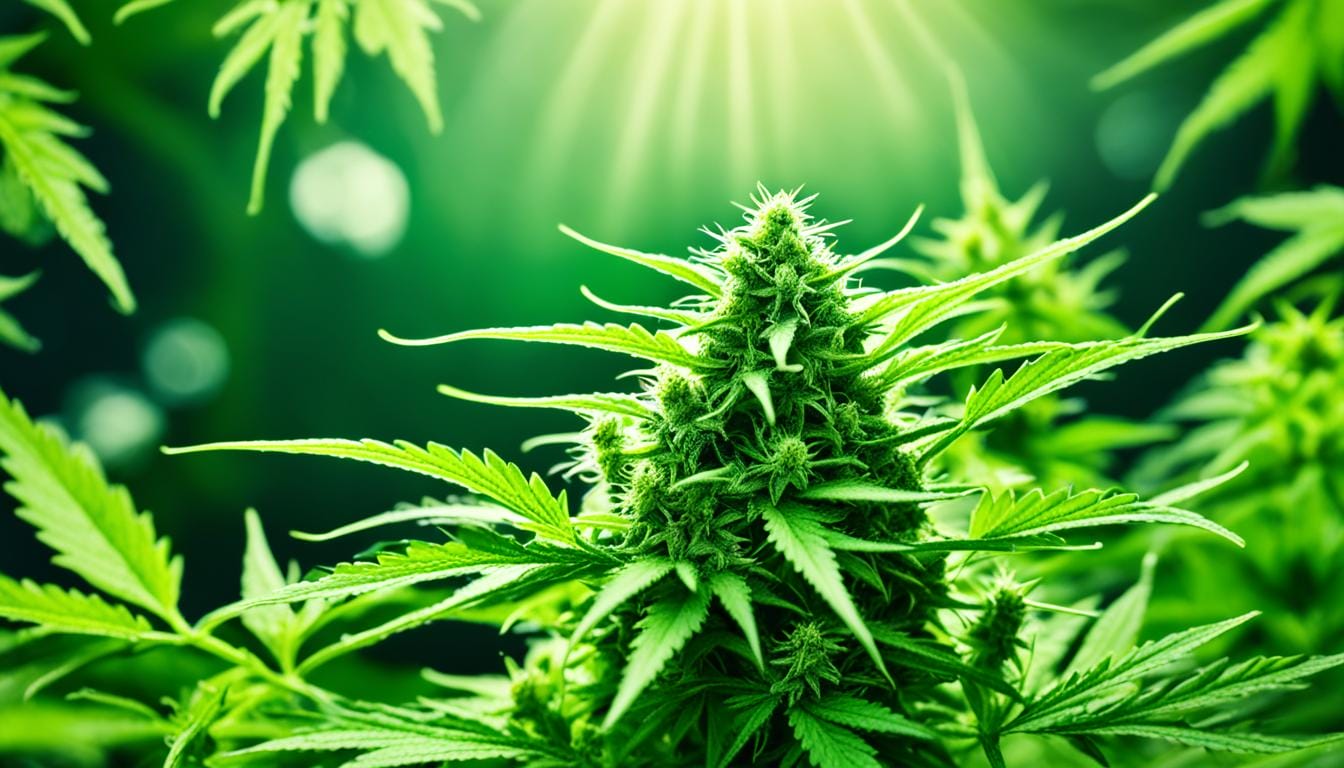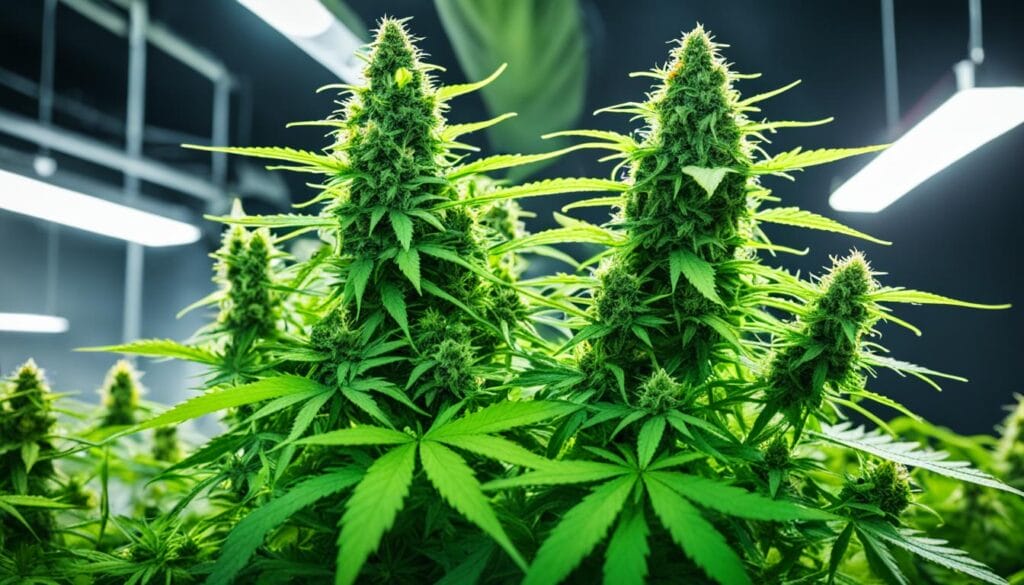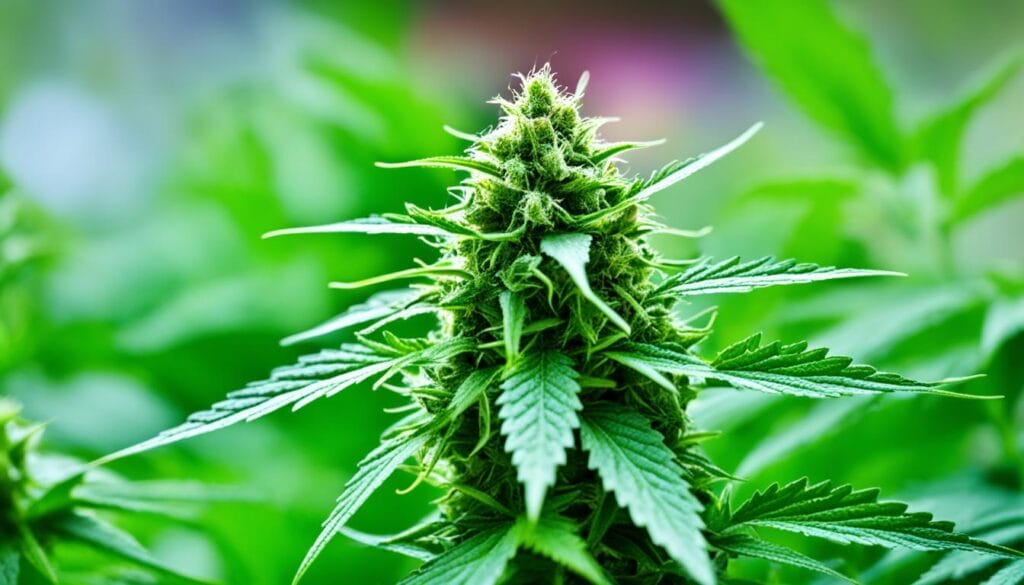Natural Pest Prevention for Feminized Cannabis Plants

Have you ever wondered why 90 percent of home cannabis growers experience pest problems with their crops? This surprisingly high percentage illustrates the urgency and magnitude of the need for effective pest prevention strategies, especially in feminized cannabis plants. Luckily, various natural solutions and organic pest control practices for cannabis can help prevent such prevalent challenges, proving both effective and sustainable.
Garden pests are naturally more attracted to the sweet, sticky flowers of cannabis than the leaves, which often leads growers to discover their unwanted guests at harvest time when inspecting the buds for consumption. This could be avoided with a proactive pest management strategy, specifically designed for the nuances of feminized cannabis plants.
From providing your plants with optimal health to making specific soil adjustments, there are easy, all-natural ways to keep unwanted insects at bay. Additionally, organic homemade foliar sprays can also be used during different growth stages—vegetative and flowering—as routine solutions to maintain pest prevention.
Key Takeaways:
- Feminized cannabis plants often attract pests during their flowering stage.
- Almost 90 percent of home cannabis growers have faced pest-related challenges, underlying the gravity of this issue.
- There are effective natural solutions and methods for organic pest prevention in cannabis plants.
- Preventive strategies and a proactive approach can greatly reduce the prevalence of pests on feminized cannabis plants.
- Soil amendments and organic homemade foliar sprays can be used in different growth stages for routine pest prevention.
Understanding the Risks: Common Pests Targeting Cannabis Plants
Dealing with pests in the world of cannabis cultivation is an unfortunate reality. These common adversaries can wreak havoc on your cannabis plants, leading to a significant decrease in yield and quality. This section aims to provide a detailed overview of typical pests that target cannabis plants, their impact on your harvest, and natural remedies for cannabis pest control.
Identifying Common Cannabis Pests
Several pests find cannabis plants to be an alluring target. Some of these common cannabis pests include thrips, whiteflies, spider mites, leaf miners, aphids, and cabbage loopers. Each pest presents unique challenges and, if left unchecked, can severely impact your cannabis plants.
| Pest | Appearance | Damage Impact |
|---|---|---|
| Thrips | Small, thin insects with fringed wings | Leaves silver damage and black spots |
| Whitefly | Tiny, moth-like insects | Causes yellowing and wilting of leaves |
| Spider Mites | Tiny mites that weave a fine web | Leaves yellow spots and can cause complete defoliation |
| Leaf Miners | Larvae that live inside plant leaves | Causes winding trails and deformation of leaves |
| Aphids | Small, soft-bodied bugs | Distorts growth and decreases plant vigor |
| Cabbage Loopers | Green, inchworm-like caterpillars | Eats holes in leaves and can cause defoliation |
The Impact of Pests on Feminized Cannabis
The invasion of pests on cannabis plants can lead to issues such as mold, especially when pests like cabbage loopers leave behind fecal matter within the buds. Pests can also significantly diminish the yield and quality of your cannabis harvest, leading to an unfavorable consumer experience. Hence, adopting conscientious cannabis pest control measures is necessary to protect your organic feminized cannabis plants.
Growers can take targeted action with heightened vigilance and a robust understanding of these common cannabis pests. Natural remedies for cannabis pests can be useful in these scenarios, ensuring the health of your plants while promoting a sustainable cannabis cultivation approach.
Creating a Healthy Growing Environment for Pest Prevention
When it comes to developing ways to protect cannabis plants from pests, an answer lies in enhancing the growing environment itself. A comprehensive and conscious approach to fortifying the cultivated environment has proven effective in managing pests that target feminized cannabis plants. This involves elevating soil quality and ensuring proper ventilation, game-changing measures that equip plants to naturally fend off potential pests.

The Importance of Soil Quality in Pest Prevention
Just as a well-nourished human body is the best defense against diseases, superior soil quality offers plants a robust shield against unwanted pests. Enriching the soil with organic matter, useful microbes, earthworms, and top-notch compost improves plant resilience, rendering them immune to stress, drought, diseases, and pests. On the contrary, plants solely depending on synthetic fertilizers might invite pests, thereby making organic soil enhancement a forefront solution for pest management in feminized cannabis plants.
Breathing Room: Proper Ventilation and Pest Management
Apart from soil quality, good aeration and ventilation play pivotal roles in preventing the manifestation of various pests, particularly in indoor cultivation spaces. Inadequate moveable air forms ripe grounds for issues like mold, which are known to thrive in stagnant, humid conditions. Consequently, implementing suitable ventilation strategies works to nip such issues in the bud, making growing spaces inhospitable for pests and reducing the chance of infestations. In essence, creating the right conditions for growth is an indispensable pillar in building natural and effective pest-prevention strategies for cannabis cultivators.
Organic Amendments: Strengthening Your Cannabis Plants Naturally
Feminized cannabis cultivators are increasingly realizing the benefits of incorporating organic amendments into their growing practices. Organic amendments not only provide a natural deterrent against pests but also nourish the plant with essential nutrients. Let’s delve into some notable organic amendments that could prove instrumental in your quest to control pests on cannabis organically.
Neem Seed Meal: Primarily recognized for its nutritional benefits, neem seed meal also doubles as a pest repellent due to its distinct pungent aroma. Its potency against soil nematodes and pathogens is remarkable, making it a go-to organic amendment for many disgruntled growers battling these pests.
Crustacean Meal: Root-knot nematodes rank among some of the most devastating pests that cannabis growers combat. Incorporating crustacean meal into your growing practices could be the game-changer you need. Crustacean meal is not only nutrient-rich and environmentally sustainable but also a natural bio-pesticide effective against root-knot nematodes.
Beyond these, routine applications of aloe vera and silica also significantly improve the plant’s immunity and resilience.
| Organic Amendment | Nutritional Benefit | Pest Control Benefit |
|---|---|---|
| Neem Seed Meal | Rich in Nitrogen, Phosphorus, and Potassium | Repels Soil Nematodes and Pathogens |
| Crustacean Meal | Rich in Nitrogen, Calcium, Magnesium, and Chitin | Combats Root-knot Nematodes |
| Aloe Vera | Boosts Plant Immunity | Enhances Resistance to Pests |
| Silica | Strengthens Plant Cell Walls | Improves Resistivity Against Fungal Diseases and Pests |
Keeping these tips for pest prevention on cannabis plants in mind and integrating these organic amendments into your practices could significantly boost your cannabis cultivation success rate and yield healthier, pest-resistant plants.
How To Prevent Common Pests on Feminized Cannabis Plants: Natural Solutions
In this section, we delve into some key strategies, particularly by optimizing plant health and integrating key soil amendments, to prevent pests on feminized cannabis as part of our commitment to organic pest prevention for cannabis. Both these strategies contribute significantly to creating a robust growing environment that deters pest invasion.
Optimizing Plant Health and Resistance
Cannabis plants, like any other life form, thrive best when in good health. A healthy plant is more resilient to pest invasions and can often withstand minor infestations without undergoing any major damage. Good health starts from the root. Ensuring healthy soil composition is vital for the plant’s overall well-being, thereby making it less susceptible to pests.
Integrating Key Soil Amendments
Certain soil amendments have been shown to be effective in helping prevent pests on feminized cannabis. Selecting appropriate nutrients and organic matter can boost the soil’s quality, providing the plants with the necessary nutrition and keeping them healthy and resistant to pest invasions.
| Soil Amendment | Benefit |
|---|---|
| Neem Seed Meal | Boosts immunity of the plant and repels pests due to its pungent aroma. |
| Crustacean Meal | High in Chitin, helps enhance the plant’s immunity and deters some root-attacking pests. |
| Aloe Vera | When applied as a foliar spray, it forms a protective layer over the plant surface, keeping pests away and aiding in disease resistance. |
| Silica | Strengthens the plant’s cell walls, making it difficult for pests to penetrate and invade the plant. |
Proper and regular integration of these amendments into the growing mix not only nourishes cannabis plants but also protects them against common pests. Such organic pest control methods pave the way for a pest-free and abundant yield of feminized cannabis.
Leveraging the Power of Beneficial Insects for Pest Control
As the saying goes, the best offense is a good defense. This statement holds true particularly for cannabis cultivation. Apart from improving the nutritional condition of plants, introducing natural predators in your growing area can help keep common pests at bay. Among the myriad of natural solutions out there, capitalizing on beneficial insects for cannabis pest control can help maintain the ecological balance in your garden, reducing the need for artificial interventions.
Encouraging Ladybugs and Lacewings in Your Garden
Home to hundreds of tiny soldiers with an insatiable appetite for aphids, ladybugs serve as an organic army of pest controllers. A single ladybug can consume up to 50 aphids a day, making them an ideal biological control method against such pests. Lacewings are also remarkably helpful by feeding on several types of soft-bodied pests and their eggs. As a grower, it makes sense to invite these beneficial creatures to protect your cannabis from these harmful invaders.
Exploring the Benefits of Predatory Insects
Predatory insects are not to be feared but rather seen as allies in your cannabis gardening journey. These allies, such as ladybugs and lacewings, have a voracious appetite for harmful pests, rendering a substantial impact on maintaining an ecological balance in your garden. It is crucial to remember that using synthetic pesticides can harm these beneficial insects, hence moving towards organic, natural solutions is the better path to take.
After all, why compromise on the quality of your cannabis or disrupt the ecological balance when nature itself avails some of the best warriors to tackle these nuisances? Invite beneficial insects into your garden, and let them do what they do best—maintain the balance.
Natural Ingredients for Pest Prevention on Cannabis Plants
Incorporating natural ingredients into your pest prevention strategy can significantly reduce the occurrence and impact of pests on cannabis plants. When used dutifully and strategically, these ingredients provide an organic and effective defense against common cannabis pests.

Neem Oil: A Natural Pest Repellent
Neem oil, a derivative of the seeds of the neem tree, is a widely recognized organic insecticide that’s effective against a variety of small, soft-bodied insects. It acts as a potent natural repellent and also combats fungal infections such as powdery mildew, providing a twofold defense for your cannabis plants. What’s more, neem oil accomplishes this without causing collateral damage to beneficial insects like ladybugs, preserving the ecological balance within your garden.
Greening Your Pest Control: Using Aloe Vera and Silica
Other naturally sourced substances like aloe vera and silica offer additional benefits in pest control. These substances can be used in foliar sprays or incorporated into the watering routine, boosting the plant’s vitality and resilience. Acting in synergy, they strengthen your plants’ defense mechanisms, helping them withstand pest attacks more effectively.
Understanding the benefits of these natural ingredients is critical for successful organic pest prevention for cannabis. The table below summarizes each ingredient’s main characteristics, uses, and advantages.
| Natural Ingredient | Uses | Advantages |
|---|---|---|
| Neem Oil | As a foliar spray applied directly on plant surfaces | Effective against soft-bodied insects, manages fungal infections, safe for beneficial insects |
| Aloe Vera and Silica | In foliar sprays or mixed with water for watering plants | Bolsters plant defenses and resilience, compatible with other pest management techniques |
Seasonal Pest Management Strategies for Cannabis Cultivation
Preventing pests from affecting the growth and quality of feminized cannabis plants is a seasonally-adjusted process. Your pest management strategies must be flexible enough to vary with the changing seasons. Each season brings its unique challenges, and your approach to combating potential infestations must account for these changes.
Understanding the life cycle of various pests is the first step towards drawing up an effective strategy. This knowledge will enable growers to implement timely applications of organic sprays, introduce beneficial insects, and adjust cultivation practices to either preemptively deter pests or respond to an infestation. Particular care is required during the vegetative and flowering stages to avoid applying materials that could affect the taste or safety of the final product.
Here’s a brief overview of the different strategies to consider in your pest management for feminized cannabis.
| Season | Pests Commonly Found | Pest Management Strategies |
|---|---|---|
| Spring | Aphids, Whiteflies | Timely application of organic sprays, Introducing beneficial insects like ladybugs |
| Summer | Spider mites, Thrips | Application of neem-based sprays, Introduction of predatory mites to eat the pests |
| Autumn | Powdery Mildew, Leaf Miners | Applying organic fungicides, Regular removal of affected leaves |
| Winter | Phytophthora (Root Rot), Mold | Improving ventilation, Implementing appropriate watering schedules |
Remember that these tips for pest prevention on cannabis plants are intended to work across seasons. Continual monitoring and immediate response to any signs of infestation are the key to keeping your plants healthy and productive.
Understanding the Lifecycle of Cannabis Pests
Part of effective pest prevention involves having a clear understanding of cannabis pests’ lifecycle. By anticipating when they might appear and what conditions they thrive in, growers can preemptively implement measures to deter pests. Throughout the various stages of a cannabis plant’s life, the approach to pest control varies significantly.
Preventative Measures During Different Growth Stages
During the vegetative growth stage, a cannabis plant is less susceptible to extensive damage, allowing growers a fair amount of leeway in their choice of pest prevention measures. A popular method is the utilization of neem-based sprays. Neem, with its pest-repelling qualities, will deter many pests from establishing themselves on your plants. This organic approach aligns with safe pest control practices while catering to the nutritional needs of the plant. However, growers need to be careful about when and how they apply these sprays to avoid any negative impacts on the plants.
Addressing Pest Challenges in Vegetative vs. Flowering Phases
The flowering phase is when cannabis plants tend to be particularly vulnerable to pests. During this phase, it is critical to use pest control measures that are both effective and gentle on the plants. Some of the milder options include the application of natural deterrents like essential oils that are known for their pest-repelling properties. The focus should be on preserving the integrity of the plant and its flowers while combating any potential pest infestations. Employing cannabis pest prevention tactics effectively hinges on an intimate understanding of the lifecycle of pests and the growth phases of the cannabis plant.
Preparation and Application of Organic Foliar Sprays
While offering unparalleled advantages, feminized cannabis plants encounter pest challenges that can drastically affect their health and yield. Organic foliar sprays have emerged as a practical and eco-friendly solution for this problem, providing effective cannabis pest control while consistently upholding plant health.
The efficacy of these foliar sprays varies during the cannabis plant’s different growth stages. Let’s delve into the fine details of preparing and applying these essential tools in a grower’s arsenal.
Vegetative Stage: A Neem-Based Foliar Spray Recipe
In the vegetative stage, cannabis plants are fervently increasing their biomass—an event that commonly attracts pesky pests and diseases. Amidst this surge in plant growth, an effective pest deterrent is a simple blend of neem oil, water, and organic liquid soap.
Neem Oil, extracted from the seeds of the Neem tree, is a natural pesticide that interrupts the life cycle of pests at all stages (adult, larvae, and egg), ensuring comprehensive pest protection.
- Mix 5 ml of neem oil with 1 liter of water.
- Add a few drops of organic liquid soap (it acts as an emulsifier)
- Apply the solution in early morning or late afternoon to avoid burning your plants.
Flowering Stage: Protecting Buds with Safe Sprays
As the cannabis plant proceeds to the flowering stage, it becomes even more critical to protect the developing buds from potential harm. However, harsh sprays at this delicate phase can leave residues that affect the final yield’s taste and safety.
During the flowering stage, organic foliar sprays composed of extremely mild ingredients like potassium bicarbonate and essential oil blends serve as a safe, effective measure against common cannabis pests.
- Mix 1 tablespoon of potassium bicarbonate with 1 liter of water.
- Add a few drops of a blend of essential oils (like peppermint or rosemary). Their strong scents confuse and deter pests.
- Spray during cooler periods of the day and avoid drenching the buds.
These recipes and applications should be carefully followed to avoid the pitfalls of pest management, such as bud rot or mold resulting from incorrect spraying techniques or overuse of products.
Non-Toxic Alternatives to Chemical Pesticides
As a cultivator, ensuring the safety and quality of your marijuana plants is paramount. Opting for non-toxic alternatives to traditional pesticides is a viable way to manage pests on feminized plants, while also promoting sustainability and safety. From deploying natural deterrents like essential oils to formulating homemade solutions, these organic methods offer a balanced synergy between effective pest control and environmental conscientiousness.
Using Essential Oils as Natural Pest Deterrents
Essential oils are an interesting alternative to harsh chemical pesticides. Oils such as eucalyptus, peppermint, and rosemary work excellently as natural insect repellents. Their potent aromas deter common pests like aphids, whiteflies, and spider mites.
The beauty of essential oils is their versatility. Not only do they deter pests, but they also contribute to enhancing the overall health of the plant.
Homemade Garlic and Chili Pepper Solutions
Delving into more domestic solutions, culinary ingredients such as garlic and chili peppers can offer proficient organic pest prevention options. To do this, you only need to mix these ingredients with water and then apply them to affected cannabis plants. It’s an economical and health-conscious solution to keep pesky infestations at bay.
| Ingredient | Preparation | Action against Pests |
|---|---|---|
| Garlic | Crushed and mixed with water | Repels aphids and other small insects |
| Chili Peppers | Crushed and mixed with water | Repels a variety of insects and pests |
It’s important to remember that both of these homemade remedies are non-toxic and not harmful to the environment or human health. Embracing these non-toxic approaches to marijuana plant protection means more than just successful cultivation; it also shows commitment to responsible and sustainable practices.
Maintaining Vigilance: Regular Monitoring for Early Detection
In cannabis cultivation, achieving a healthy and fruitful yield of feminized plants hinges on two crucial factors: regular monitoring and early detection of cannabis plant pests. The significance of these twin pillars cannot be overstated when combatting pest infestation. A consistent check on overall plant health, coupled with a proactive approach, makes a world of difference in preserving the vitality of your crops.
Signs of Infestation and Immediate Response Techniques
Being attuned to warning signs of infestation is your first line of defense. Red flags can include yellowing or curled leaves, as well as, small moving dots visible on plant foliage. Spotting these early indicators enables cannabis growers to take immediate action. Rapid response strategies often involve the application of appropriate organic remedies tailored to the specific pest at hand. Additionally, modifications to regular cultivation practices might be required to effectively address the inflicted damage. Always remember that swift action is the linchpin for successful pest management.
Setting Up an Effective Monitoring Schedule
The creation of a structured and regular monitoring schedule forms part and parcel of a proficient pest prevention strategy. An effective schedule does not necessarily mean an onerous commitment. It can be as straightforward as setting aside dedicated time twice or thrice a week for thorough plant checks. Building this routine enhances the cultivator’s ability to spot infestations early, respond appropriately, and maintain the health of the feminized cannabis plants. In conclusion, adhering to a vigilant inspection regimen will go a long way in protecting your cannabis yield from pest invasions.
FAQs
What are the common pests that target feminized cannabis plants?
Common pests include thrips, whiteflies, spider mites, leaf miners, aphids, and cabbage loopers. If not managed, these pests can significantly impact the quality and yield of the cannabis harvest and lead to mold and other issues.
How can a healthy growing environment help in pest prevention?
Healthy soil enriched with organic matter, microbes, worms, and quality compost improves the plant’s defense mechanisms against stress, drought, diseases, and pests. Good aeration and ventilation, especially in indoor settings, can prevent issues like mold, which thrives in stagnant, humid environments.
How can organic amendments strengthen cannabis plants against pests?
Organic amendments like neem seed meal and crustacean meal can nourish the plants and repel pests. Regular applications of aloe vera and silica further enhance a plant’s immunity and resilience, providing a natural defense against common pests.
What role do beneficial insects play in organic cannabis pest prevention?
Beneficial insects like ladybugs and lacewings can organically control pest populations on cannabis plants. Ladybugs can consume up to 50 aphids a day, and lacewings feed on a variety of soft-bodied pests.
How can neem oil be used as a natural pest repellent?
Neem oil, derived from the seeds of the neem tree, is an effective organic insecticide against small, soft-bodied insects. It also repels pests and manages fungal infections like powdery mildew without harming beneficial insects like ladybugs.
How can I tailor organic pest management practices to the growth stage of cannabis plants?
By understanding the life cycle of various pests, growers can implement timely organic sprays, introduce beneficial insects, and adjust cultivation practices to deter pests or respond to an incursion. For instance, during the vegetative growth stage, neem-based sprays can be utilized without the risk of affecting the buds.
What are some non-toxic alternatives to traditional pesticides?
Essential oils like eucalyptus, peppermint, and rosemary repel insects naturally. Homemade solutions using garlic or chili peppers provide additional organic pest prevention options that are not harmful to the environment or human health.
How important is maintaining a consistent monitoring schedule in early pest detection and management?
Establishing a regular monitoring schedule is crucial for the early detection and management of cannabis plant pests. Growers should be on the lookout for common signs of infestation, such as yellowing or curled leaves and small moving dots on the foliage.
Suggested Articles
;)
;)
;)




 18 Jun 2025
18 Jun 2025  25 min read
25 min read


 March 10, 2025
March 10, 2025 


RESPONSES (0)
No responses yet. Be the first to respond!